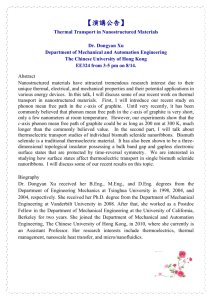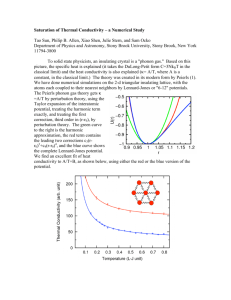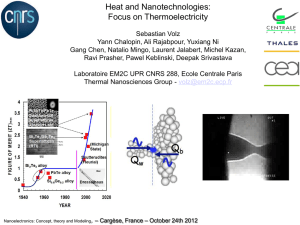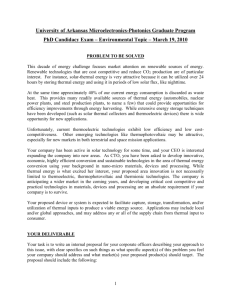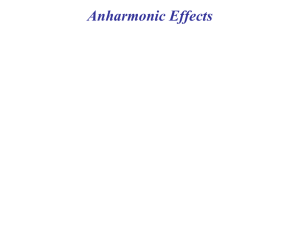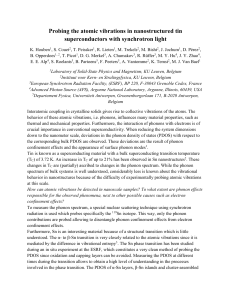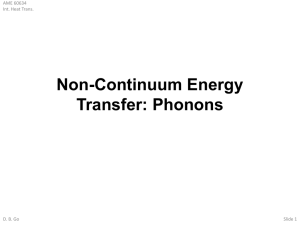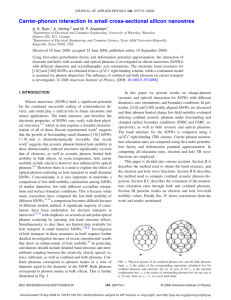PDF - OMICS Group
advertisement
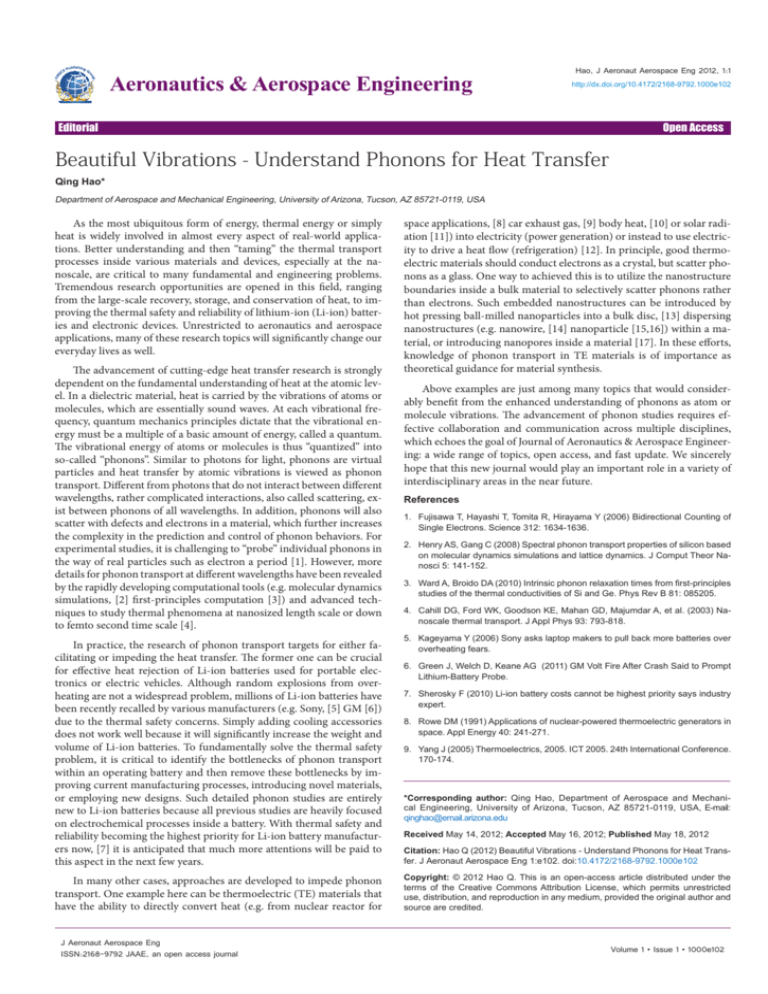
Aeronautics & Aerospace Engineering Hao, J Aeronaut Aerospace Eng 2012, 1:1 http://dx.doi.org/10.4172/2168-9792.1000e102 Editorial Open Access Beautiful Vibrations - Understand Phonons for Heat Transfer Qing Hao* Department of Aerospace and Mechanical Engineering, University of Arizona, Tucson, AZ 85721-0119, USA As the most ubiquitous form of energy, thermal energy or simply heat is widely involved in almost every aspect of real-world applications. Better understanding and then “taming” the thermal transport processes inside various materials and devices, especially at the nanoscale, are critical to many fundamental and engineering problems. Tremendous research opportunities are opened in this field, ranging from the large-scale recovery, storage, and conservation of heat, to improving the thermal safety and reliability of lithium-ion (Li-ion) batteries and electronic devices. Unrestricted to aeronautics and aerospace applications, many of these research topics will significantly change our everyday lives as well. The advancement of cutting-edge heat transfer research is strongly dependent on the fundamental understanding of heat at the atomic level. In a dielectric material, heat is carried by the vibrations of atoms or molecules, which are essentially sound waves. At each vibrational frequency, quantum mechanics principles dictate that the vibrational energy must be a multiple of a basic amount of energy, called a quantum. The vibrational energy of atoms or molecules is thus “quantized” into so-called “phonons”. Similar to photons for light, phonons are virtual particles and heat transfer by atomic vibrations is viewed as phonon transport. Different from photons that do not interact between different wavelengths, rather complicated interactions, also called scattering, exist between phonons of all wavelengths. In addition, phonons will also scatter with defects and electrons in a material, which further increases the complexity in the prediction and control of phonon behaviors. For experimental studies, it is challenging to “probe” individual phonons in the way of real particles such as electron a period [1]. However, more details for phonon transport at different wavelengths have been revealed by the rapidly developing computational tools (e.g. molecular dynamics simulations, [2] first-principles computation [3]) and advanced techniques to study thermal phenomena at nanosized length scale or down to femto second time scale [4]. space applications, [8] car exhaust gas, [9] body heat, [10] or solar radiation [11]) into electricity (power generation) or instead to use electricity to drive a heat flow (refrigeration) [12]. In principle, good thermoelectric materials should conduct electrons as a crystal, but scatter phonons as a glass. One way to achieved this is to utilize the nanostructure boundaries inside a bulk material to selectively scatter phonons rather than electrons. Such embedded nanostructures can be introduced by hot pressing ball-milled nanoparticles into a bulk disc, [13] dispersing nanostructures (e.g. nanowire, [14] nanoparticle [15,16]) within a material, or introducing nanopores inside a material [17]. In these efforts, knowledge of phonon transport in TE materials is of importance as theoretical guidance for material synthesis. Above examples are just among many topics that would considerably benefit from the enhanced understanding of phonons as atom or molecule vibrations. The advancement of phonon studies requires effective collaboration and communication across multiple disciplines, which echoes the goal of Journal of Aeronautics & Aerospace Engineering: a wide range of topics, open access, and fast update. We sincerely hope that this new journal would play an important role in a variety of interdisciplinary areas in the near future. References 1. Fujisawa T, Hayashi T, Tomita R, Hirayama Y (2006) Bidirectional Counting of Single Electrons. Science 312: 1634-1636. 2. Henry AS, Gang C (2008) Spectral phonon transport properties of silicon based on molecular dynamics simulations and lattice dynamics. J Comput Theor Nanosci 5: 141-152. 3. Ward A, Broido DA (2010) Intrinsic phonon relaxation times from first-principles studies of the thermal conductivities of Si and Ge. Phys Rev B 81: 085205. 4. Cahill DG, Ford WK, Goodson KE, Mahan GD, Majumdar A, et al. (2003) Nanoscale thermal transport. J Appl Phys 93: 793-818. 5. Kageyama Y (2006) Sony asks laptop makers to pull back more batteries over overheating fears. In practice, the research of phonon transport targets for either facilitating or impeding the heat transfer. The former one can be crucial for effective heat rejection of Li-ion batteries used for portable electronics or electric vehicles. Although random explosions from overheating are not a widespread problem, millions of Li-ion batteries have been recently recalled by various manufacturers (e.g. Sony, [5] GM [6]) due to the thermal safety concerns. Simply adding cooling accessories does not work well because it will significantly increase the weight and volume of Li-ion batteries. To fundamentally solve the thermal safety problem, it is critical to identify the bottlenecks of phonon transport within an operating battery and then remove these bottlenecks by improving current manufacturing processes, introducing novel materials, or employing new designs. Such detailed phonon studies are entirely new to Li-ion batteries because all previous studies are heavily focused on electrochemical processes inside a battery. With thermal safety and reliability becoming the highest priority for Li-ion battery manufacturers now, [7] it is anticipated that much more attentions will be paid to this aspect in the next few years. Citation: Hao Q (2012) Beautiful Vibrations - Understand Phonons for Heat Transfer. J Aeronaut Aerospace Eng 1:e102. doi:10.4172/2168-9792.1000e102 In many other cases, approaches are developed to impede phonon transport. One example here can be thermoelectric (TE) materials that have the ability to directly convert heat (e.g. from nuclear reactor for Copyright: © 2012 Hao Q. This is an open-access article distributed under the terms of the Creative Commons Attribution License, which permits unrestricted use, distribution, and reproduction in any medium, provided the original author and source are credited. J Aeronaut Aerospace Eng ISSN:2168-9792 JAAE, an open access journal 6. Green J, Welch D, Keane AG (2011) GM Volt Fire After Crash Said to Prompt Lithium-Battery Probe. 7. Sherosky F (2010) Li-ion battery costs cannot be highest priority says industry expert. 8. Rowe DM (1991) Applications of nuclear-powered thermoelectric generators in space. Appl Energy 40: 241-271. 9. Yang J (2005) Thermoelectrics, 2005. ICT 2005. 24th International Conference. 170-174. *Corresponding author: Qing Hao, Department of Aerospace and Mechanical Engineering, University of Arizona, Tucson, AZ 85721-0119, USA, E-mail: qinghao@email.arizona.edu Received May 14, 2012; Accepted May 16, 2012; Published May 18, 2012 Volume 1 • Issue 1 • 1000e102 Citation: Hao Q (2012) Beautiful Vibrations - Understand Phonons for Heat Transfer. J Aeronaut Aerospace Eng 1:e102. doi:10.4172/21689792.1000e102 Page 2 of 2 10. Kishi M, Nemoto H, Hamao T, Yamamoto M, Sudou S, et al. (1999) Thermoelectrics, 1999. Eighteenth International Conference. 301-307. tubes and the effects on the thermoelectric properties of nanotube-containing nanocomposites. Appl Phys Lett 86: 062111-062113. 11. Kraemer D, Poudel B, Feng HP, Caylor JC, Yu B, et al. (2011) High-performance flat-panel solar thermoelectric generators with high thermal concentration. Nat Mater 10: 532-538. 15. Kim W, Zide J, Gossard A, Klenov D, Stemmer S, et al. (2006) Thermal Conductivity Reduction and Thermoelectric Figure of Merit Increase by Embedding Nanoparticles in Crystalline Semiconductors. Phys Rev Lett 96: 045901. 12. Goldsmid HJ (1964) Thermoelectric Refrigeration. Plenum Press, New York. 16. Sootsman JR, Pcionek RJ, Kong H, Uher C, Kanatzidis MG (2006) Strong Reduction of Thermal Conductivity in Nanostructured PbTe Prepared by Matrix Encapsulation. Chem Mater 18: 4993-4995. 13. Poudel B, Hao Q, Ma Y, Lan Y, Minnich A, et al. (2008) High-Thermoelectric Performance of Nanostructured Bismuth Antimony Telluride Bulk Alloys. Science 320: 634-638. 14. Zhao XB, Ji XH, Zhang YH, Zhu TJ, Tu JP, et al. (2005) Bismuth telluride nano- 17. Tang J, Wang HT, Lee DH, Fardy M, Huo Z, et al. (2010) Holey Silicon as an Efficient Thermoelectric Material. Nano Lett 10: 4279-4283. Submit your next manuscript and get advantages of OMICS Group submissions Unique features: • • • Userfriendly/feasiblewebsite-translationofyourpaperto50world’sleadinglanguages AudioVersionofpublishedpaper Digitalarticlestoshareandexplore Special features: • • • • • • • • 200OpenAccessJournals 15,000editorialteam 21daysrapidreviewprocess Qualityandquickeditorial,reviewandpublicationprocessing IndexingatPubMed(partial),Scopus,DOAJ,EBSCO,IndexCopernicusandGoogleScholaretc SharingOption:SocialNetworkingEnabled Authors,ReviewersandEditorsrewardedwithonlineScientificCredits Betterdiscountforyoursubsequentarticles Submityourmanuscriptat:www.omicsonline.org/submission J Aeronaut Aerospace Eng ISSN: JAAE, an open access journal Volume 1 • Issue 1 • 1000e102
